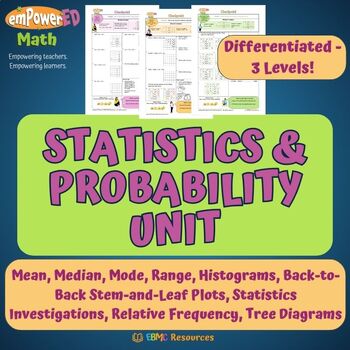Full Unit: Statistics & Probability (Differentiated)
emPowerED Math by EBMC Resources
1 Follower
Grade Levels
4th - 6th, Homeschool
Subjects
Resource Type
Standards
CCSS7.SP.A.1
CCSS7.SP.A.2
CCSS7.SP.B.3
CCSS7.SP.B.4
CCSS7.SP.C.5
Formats Included
- PDF
Pages
73 pages
emPowerED Math by EBMC Resources
1 Follower
Description
Empower your learners with our fully differentiated unit! This unit has everything you need to teach. These colorful, engaging, structured worksheets are not only a no-hassle solution that nurtures numeracy skills and confidence in students, but also a great asset for substitute teachers to step in seamlessly. Just imagine all your lessons set out with this tried-and-true format!
Topics Included
- Mean, median, mode and range
- Histograms
- Back-to-back stem-and-leaf plots
- Statistics investigations
- Relative frequency
- Tree diagrams
- Tests that include these topics
What's Included
- 2 Student Notes Pages for every topic
- 3 levels of Differentiated Practice Pages for every topic: Support, On-Level, and Extension
- 1 Puzzle Page for every topic
- Engaging color-coded layouts for streamlined navigation
- Answers included for effortless grading
- Ready to integrate into your lesson plans with little to no preparation required
- A resource that empowers both full-time and substitute teachers, fostering a classroom environment where every learner thrives
Total Pages - 39 worksheets
Answer Key - YES
⏳ Teaching Duration - 3 weeks
Related Products
- Mean, Median, Mode, Range Topic Bundle
- Statistics and Probability Teaching Presentations Bundle
- Puzzles for Statistics and Probability Bundle
We are all for the well-being and work/life balance of our fellow hard-working teachers! We hope this saves you tons of planning time and gives you back more time, energy and enjoyment in the classroom!
Connect with Us:
Total Pages
73 pages
Answer Key
Included
Teaching Duration
3 Weeks
Report this resource to TPT
Reported resources will be reviewed by our team. Report this resource to let us know if this resource violates TPT’s content guidelines.
Standards
to see state-specific standards (only available in the US).
CCSS7.SP.A.1
Understand that statistics can be used to gain information about a population by examining a sample of the population; generalizations about a population from a sample are valid only if the sample is representative of that population. Understand that random sampling tends to produce representative samples and support valid inferences.
CCSS7.SP.A.2
Use data from a random sample to draw inferences about a population with an unknown characteristic of interest. Generate multiple samples (or simulated samples) of the same size to gauge the variation in estimates or predictions. For example, estimate the mean word length in a book by randomly sampling words from the book; predict the winner of a school election based on randomly sampled survey data. Gauge how far off the estimate or prediction might be.
CCSS7.SP.B.3
Informally assess the degree of visual overlap of two numerical data distributions with similar variabilities, measuring the difference between the centers by expressing it as a multiple of a measure of variability. For example, the mean height of players on the basketball team is 10 cm greater than the mean height of players on the soccer team, about twice the variability (mean absolute deviation) on either team; on a dot plot, the separation between the two distributions of heights is noticeable.
CCSS7.SP.B.4
Use measures of center and measures of variability for numerical data from random samples to draw informal comparative inferences about two populations. For example, decide whether the words in a chapter of a seventh-grade science book are generally longer than the words in a chapter of a fourth-grade science book.
CCSS7.SP.C.5
Understand that the probability of a chance event is a number between 0 and 1 that expresses the likelihood of the event occurring. Larger numbers indicate greater likelihood. A probability near 0 indicates an unlikely event, a probability around 1/2 indicates an event that is neither unlikely nor likely, and a probability near 1 indicates a likely event.





